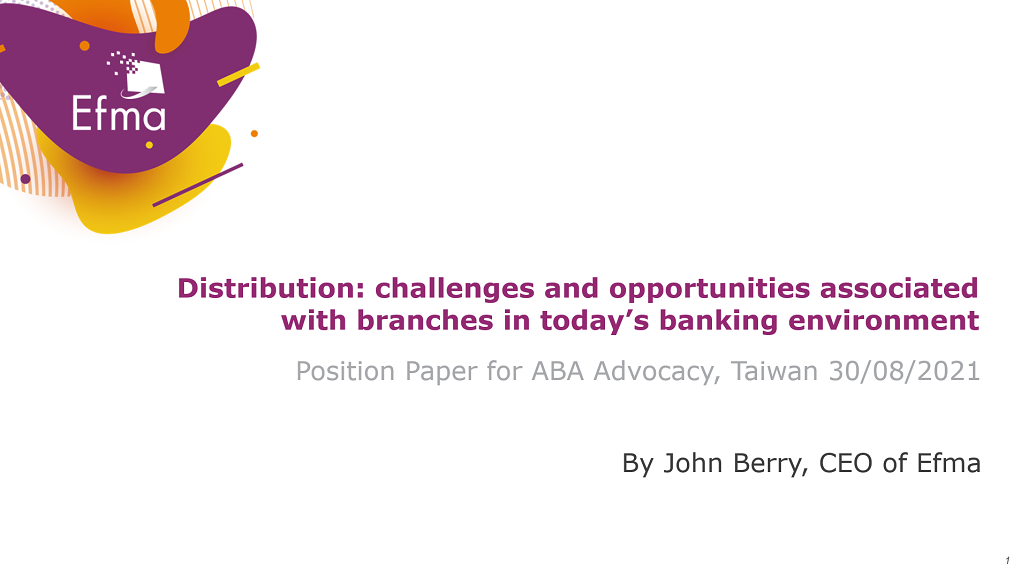Distribution: challenges and opportunities associated with branches in today’s banking environment
 I. Introduction
I. Introduction
1. Banks are closing their branches and shifting resources to digital. That is the prevailing narrative in the financial services industry. Given cost pressures, the Covid-19 pandemic, and changing customer habits, it is certainly not surprising that branches are a primary cost-cutting target of COO’s all around the globe. But while the bank branch is certainly declining in importance to banking success, it has not become obsolete. Everyone – from legacy institutions to mid-sized banks to new arrivals – is striving to find the right mix between physical and digital offerings. This has led to financial institutions maintaining a physical presence in new and innovative ways. Before we look at some of the newest iterations of the bank branch, let us first examine a changing banking landscape.
II. A challenging branch environment
2. There is no way around it: there are enormous cost pressures that come with a large physical footprint. From labor to real estate to cash requirements, the costs to maintain a branch add up quickly. It costs hundreds of thousands of dollars/euros/pounds per year to operate a branch. This is why branches are often viewed as a primary way to cut costs and streamline operations.
3. Furthermore, the pandemic accelerated customer shift to digital in a major way. The migration to digital banking long pre-dated Covid, but throughout the pandemic, even those who may have been hesitant to make the switch to non-branch banking were forced on to digital platforms during lockdowns. Banks are delivering impressive new mobile tools and building digital spaces – such as ecosystems and marketplaces – instead of physical spaces.
4. Cost pressures combined with the shift to digital have resulted in banks closing their branches in droves. Société Générale is closing 600 of its 2,100 branches by 2025. The three biggest banks in the U.S. – Wells Fargo, Citigroup, and JPMorgan – closed more than 250 branches in the first half of 2021 alone, with more on the way. More than 4,000 bank and building society branches have closed in the U.K. over the past six years, according to a report from consumer group Which, at a rate of about 50 a month. Those examples aren’t exhaustive, but it is the same story in virtually every geographic region.
5. The evolving role of branches is a clear response to changes in customer behavior. All recent and upcoming Efma reports focus on digital trends – from SME banking to digitalization in Canada. There is no longer any need to even call it “digital banking.” There is, however, a consistent theme we hear from bankers around the world when it comes to handling more complex banking needs like mortgages and investment advice: there will always be a need for the human element. And neglecting the human element comes with risks.
6. A new study in France shows the perils of delivering a subpar in-person experience. In our social media-driven era, everyone’s a critic. Online, people rank, opine, and critique. These appraisals can be the difference between a new business succeeding or failing. With people turning to the internet for all manner of decisions – what to buy, where to eat, where to travel – online opinion is incredibly powerful and influential. Banks, mindful of the consumer shift to digital, are keenly aware of their app ratings and net promoter scores. They are all striving to deliver a better digital experience, understanding that is how the next generation is banking.
7. As it turns out, however, banks shouldn’t be neglecting their real-world offerings. In a recent study published by Sia Partners, it was observed that in France there is a growing tendency to rate in-person experiences at bank branches. On Google and other social media sites, French people are recounting their in-person experiences with banks. Unfortunately, French banks aren’t receiving glowing reviews. People are talking about the incompetence of bank agents, how they are never reachable at the right hours, and describing overall negative experiences.
8. “All brands and all industries combined, it is estimated that below four stars, on a scale of five, customer satisfaction is not very good. However, the scores of the banks are well below four or even three,” according to Thomas Rocafull, Head of Financial Services at Sia Partners. French banks are delivering consistently disappointing branch experiences to their customers. Instead of being spaces where customers feel welcome and can conveniently take care of their banking needs, branches are receiving some of the worst scores across all brands and industries. And Google reviews do not go unread in dark corners of the internet. According to one reviewtrackers, more than 6 in 10 consumers look at Google reviews.
9. Even if bank branches are diminishing in their importance to long-term strategies, real-world experiences still have ramifications. People can recallnegative experiences with much more clarity than positive experiences. This can be a problem if you are a financial institution that has disregarded the branch experience. People are 21% more likely to leave a negative review after an experience than a positive one. In the financial industry, where brand reputation and trust are vital to success, these adverse experiences can steadily erode a core metric.
10. Low bank ratings are part of the broader trend of shifting consumer expectations. The model that neobanks have followed, with many making customer service available 24/7, has highlighted the inconvenience of previous, limited models of service. Customers expect immediacy and responsiveness from the companies with whom they interact. A bank branch is still confined to normal operating hours and logistical limitations. Maybe they need to send information to a different part of the bank and wait for a response. Or they have a next appointment to attend to, so they hurry along customers, lacking a personal touch. Whatever the reasons may be, many bank branches aren’t delivering the type of on-demand, instant banking experience that customers expect.
11. The problem is that banks might be abandoning one of their competitive advantages against neobanks. Typically, neobanks produce an incredible digital product and experience compared to traditional financial institutions. These are fintechs, after all, and they hire more UX designers than loan officers. But traditional banks have an advantage by being present in communities. They aren’t merely some app designed by a team of engineers and data scientists in Tel Aviv or Singapore. Many customers still expect to have a bank branch nearby if they need it. The transition to fully digital banking can be tricky because there are still many customers who rely on in-person transactions for various functions. Being able to pop into the bank just down the street remains a valuable and sometimes necessary proposition. And it can paradoxically be a unique value proposition in our digitally-driven world. Even Amazon is opening in-person stores.
11. For banks, the question is how to strike the correct balance between in-person services, cost reduction, and digital tools? The next section looks at some of the innovative ways financial institutions are rising to this challenge.
III. Challenges are spurring innovation and reimagination
13. With the bank branch clearly evolving, the newest iterations have come a long way from the branches of the past. Some fascinating examples highlight the influence of other industries as well as some new, digitally-centered ideas about how to use and optimize physical space.
The sharing economy is often used in reference to individuals renting their apartment on AirBnB while on holiday or loaning out their car via an app to make some extra cash. But now, banks want in on the sharing action.
14. In England, “BankHUB” is the new bank sharing space. The largest banks have shuttered branches in many of the smallest English towns. Now, they are attempting to reestablish a presence in these “banking deserts” by splitting one physical location among five banks. NatWest gets Monday, Lloyds gets Tuesday, Santander on Wednesday, and so on. So far, it is only being trialed in a few small British towns that have been hit particularly hard by branch closures. But it is a way for banks to maintain at least a minor presence in towns that had previously been abandoned.
15. Another example from the UK shows how one bank’s trash is another company’s treasure. OneBanks is a company that believes they have struck gold with a business model that aims to help people navigate an open banking world. They have createda physical hub that can welcome customers from all different banks. Embracing the spirit of open banking, they offer advice and services to people no matter their bank. As their motto states: “Your local bank branch might be closed, but OneBanks is open.”
16. The limits to the bank rotation model are evident. With OneBanks, for example, their employees can only help customers with basic tasks like setting up accounts, making payments, and account aggregation. They won’t be able to set up a mortgage for your new house. Furthermore, life events don’t organize themselves around the rotation schedule at your local multi-bank branch. What happens if you urgently need a loan but your bank’s lone day of the week was yesterday? Your dream home could be off the market by the time you finally speak with a representative from your institution. These aren’t the consistent, full-service centers from 15 years ago.
17. In Russia, however, there is proof that not every bank is abandoning their own branch network. At SBER, the “Branch as a gadget” concept means their customers now have many reasons for visiting the bank branch beyond mere financial transactions. Customers can receive packages, use wi-fi, have a cup of coffee, print documents, and attend community events. Just like any good, multi-use gadget, their branches have been designed with the user in mind. Everything is clearly visible with no barriers. It is an intuitive, phygital space with products, services, and entertainment easily accessed. Employees are not just processing checks but instead are advising, helping customers navigate SBER’s vast ecosystem of services, and serving as brand ambassadors. SBER is transforming what people come to expect from their trip to the bank. “It is a space for a comfortable and convenient life besides being just a place where you go to withdraw money, open a savings account, consult or apply for a loan. You can learn new technologies, hold business and friendly meetings, make purchases, receive parcels and do many other things that were impossible at the ordinary bank branch,” said Alexander Vedyakhin, First Deputy Chairman of Executive Board at the bank.
18. There is also another type of space-sharing taking place in Vietnam. Timo, a newly founded digital bank, decided to create a physical space, or “hangout” as they call them. They partnered with 7-Eleven to place hangouts in the incredibly popular convenience stores throughout the country. Timo’s collaboration with 7-Eleven marks a long-term strategic partnership to widen the banking network by making it easier for 7-Eleven customers in Vietnam to shop for their essential needs and register for a Timo debit or credit card right in the store. In under 10 minutes, customers can enjoy a cup of coffee at 7-Eleven while creating a Timo account for free. We may not normally associate neobanks with the physical world, but this is yet another sharing
19. These examples demonstrate the incredible innovation taking place throughout the industry. As we move forward and the branch continues to evolve, what are some principles banking executives should keep in mind as they think about the branch of the future?
- Their concept will depend on the level of interaction between the channels of contact/customer service
- Branches should be designed so as to constantly change their shape and functions – thus, to meet the changing needs of customers
- They will continue to act as bastions of customer experience and brand ambassadors for seamless multi-channel interactions
- They will reduce cash handling costs while providing comprehensive product advice using digital tools and remote interaction
- They will continue to play an educational role until all their customers are comfortable using the bank’s digital channels.
20. One size won’t fit all when it comes to approaching your branch strategy in the coming years. Whether it is digitally upgrading, sharing, or eliminating entirely, banking executives have a delicate balancing act on their hands when it comes to branches. But one year on from the outset of the Covid pandemic, there is no better time than now for banks to show their customers they can deliver critical support, functionality, and delight, regardless of the channel.
The presentation file can be downloaded HERE.
The video recording of ABA Policy Advocacy Committee Meeting can be viewed in the ABA YouTube.
Prepared for the Asian Bankers Association by:
 Mr. John Berry
Mr. John Berry
CEO, EFMA

